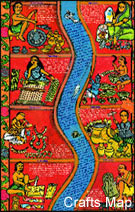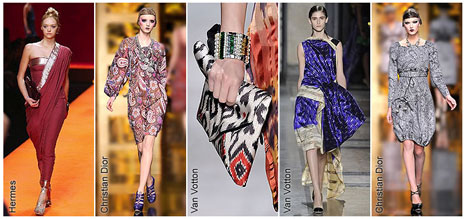 Walking down the narrow lanes of Shahpur Jat, Delhi, takes you on a ride through the backbone of Indian fashion industry which has been growing at a reverberating pace. The locality here houses craftsmen from West Bengal, Gujarat, Madhya Pradesh and all corners of the country settled with their sharpened craft tools that have gradually developed into small manufacturing units themselves. These crafts people have been providing the fine zardozi, ari work and all the glitter and shine that sashay down the ramp for the designers of our fashion fraternity.
Walking down the narrow lanes of Shahpur Jat, Delhi, takes you on a ride through the backbone of Indian fashion industry which has been growing at a reverberating pace. The locality here houses craftsmen from West Bengal, Gujarat, Madhya Pradesh and all corners of the country settled with their sharpened craft tools that have gradually developed into small manufacturing units themselves. These crafts people have been providing the fine zardozi, ari work and all the glitter and shine that sashay down the ramp for the designers of our fashion fraternity. The rich and yet scattered heritage of Indian handicrafts can be very aptly described as the Kuber’s treasure house of ideas, techniques and colours. It has the most intricate embroideries of zardozi, kantha and mukesh work; dyeing techniques like bandhini and batik; wondrous textile weaves like ikat, chanderi and brocade and innumerable other crafts that support the textiles of India.

Designers like Ritu Kumar, Abu Jani & Sandeep Khosla, Neeru Kumar, Meera & Muzafar Ali and more recently Samant Chauhan and Virtues (Ashish & Vikrant) have been very closely associated with the upliftment of various crafts. With the globalisation of fashion and Indian garments being reduced to mere costumes, the craft struggles hard to carve out a niche for itself into contemporary silhouettes. The indigenous crafts form the support system for fashion but due to its heterogeneous nature fails to get recognized as a unified body. Designers hold strong opinions that revival of craft should not just fissile out into cutting patches from old fabric of brocade or kantha and stitching them into jackets whereas the handcrafted piece of art needs a wider and more respectable canvas of expression. The wave and upsurge for bringing crafts to a higher platform has kindled, now it is the responsibility of our Indian designers to become the directional force for it.

Organisations like Dastkar, Dastkari Haat Samiti, All India Artisans & Craft workers Welfare Association have been instrumental in formatting and organizing the Arts & Crafts Industry in India. The most prominent figures that have held the reins of the craft industry are Laila Tyabji and Jaya Jaitly. Fashion and Design institutes like NIFT and NID have been proficient tools for identifying such crafts and handmade products through there specially designed craft intervention programmes with the students. These organizations have now worked over a decade to consolidate and make the crafts and craftsmen available to the contemporary market.
Shifting our focus again to the glamour world, fashion in India has always been the reflection of our infinite database of crafts. And designers come up with the most innovative and fresh designs from the traditional techniques. The recent Marie Clare’s second edition of the Made in India Fashion Awards, where young designers like Zubair Kirmani, Anupama Dayal, Pankaj & Nidhi, Atsu and many more worked in close association with individual craftsperson of specific regions to develop a special collection is a step towards the direction. And there are still miles to go.
The trumpet of crafts has not been restrained only to the Indian territories as ikat weave, paisley prints and kanjeevaram have been spotted sashaying down the International ramps. Hence zeitgeist confirms an alarm for Indian designers to realize the importance and re-establishment of Indian craft as a combined responsibility of the entire fashion industry before they become just folklores of a glorified history.









